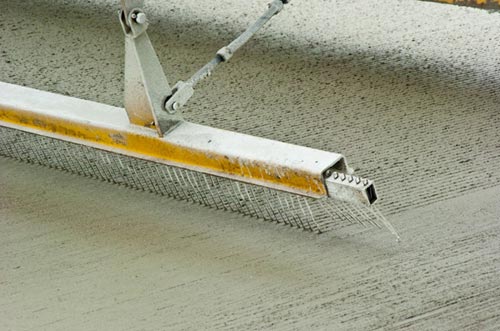Where the rubber meets the road, texture adds a measure of safety
Date Posted: February 25 2011
Driving on stretches of the 9,720 miles of State-of-Michigan-maintained highway during rain or snow events – which have especially common during this brutal winter – can you feel just a little more in control of your vehicle when driving over pavement that has been grooved or textured?
Results from research and real-world monitoring points to “yes.”
“Every other year we perform skid tests and monitor the friction numbers on the roads we maintain,” said Michigan Department of Transportation Materials Engineer John Staton. “It’s been shown that with the proper texture on either asphalt or concrete, you get better friction than if you don’t have any texture at all. It’s all about moving water from the surface of the road.”
Staton said some Michigan roads were given textured pavement 50 years ago or longer. It has only been in the last few years, he said, that MDOT specifications call for 100 percent textured pavement on re-built or new roadways. In addition to better tire adhesion to road surfaces, he said less “splash and spray” of road water can also be expected with textured surfaces.
Textured pavement is a catch-all phrase for any one of a number of methods used by building trades road builders for scoring, grooving or surface grinding road surfaces. With freshly poured concrete road surfaces, it has now become standard practice for road builders to “tine” the surface with length-wise grooves to provide added traction, and if done properly, create less road noise.
Until about 10 years ago, the Federal Highway Administration recommended transverse tining on concrete roads, and most states followed their recommendation. Transverse grooves across roadways is usually the optimum slip-resistance method, because of the design’s ability to move water off to the side.
But MDOT and other states have moved away from transverse tining because of the hum that’s created by rubber meeting the road. The din has been described as “annoying” by one study, to a noise akin to “an airplane taking off” by another researcher, which could be jarring to both drives and homes and businesses near the roadways. So longitudinal tines are usually the compromise choice for new concrete.
“There’s a lot of research going on in this area,” said Steve Karamihas, a senior research associate with the University of Michigan Transportation Research Institute. “Transverse tining is considered safer, and if safety were the only consideration, all surfaces would be textured that way. There’s research going on looking at what works best in terms of regions with different climates, and whether they get a lot of rain of snowfall. But the public hates noise, so there are compromises. It doesn’t always come down to engineering.”
The practice of tining fresh concrete roads has become part of MDOT bid packages, Staton said, and is not separated out as an extra cost. Although it’s not as easy to see, he said the surface of new asphalt roads where they’re called for on state highways are also textured to provide added slip resistance, usually to the same standard as tined concrete. Existing concrete surfaces can also be textured using an expensive grinding technique.
Michigan doesn’t keep numbers on vehicle accident avoidance on textured vs. non-textured roads. Most often, textured roads will be found on higher-speed limit trunkline roads maintained by MDOT. Localities maintain lower speed, usually non-textured roads.
MDOT’s research and practical application of textured roads isn’t done in a bubble. State DOTs across the nation share information they’ve gleaned from real-world road surface testing. In addition, several national associations and universities have weighed in with research on the effectiveness of road texturing.
“There’s no question, in terms of safety, you’re a heckuva lot better off driving on a road surface that’s been textured,” Karamihas said. “If you driving during bad weather and you have a sense that you have a little better grip on a textured surface, you’re probably right.”

CONCRETE ‘TINING’ and other pavement texturing is now standard practice during new construction and repaving of all Michigan highways in MDOT’s jurisdiction. Photo courtesy of Jim Lemay/MDOT Photo Lab
